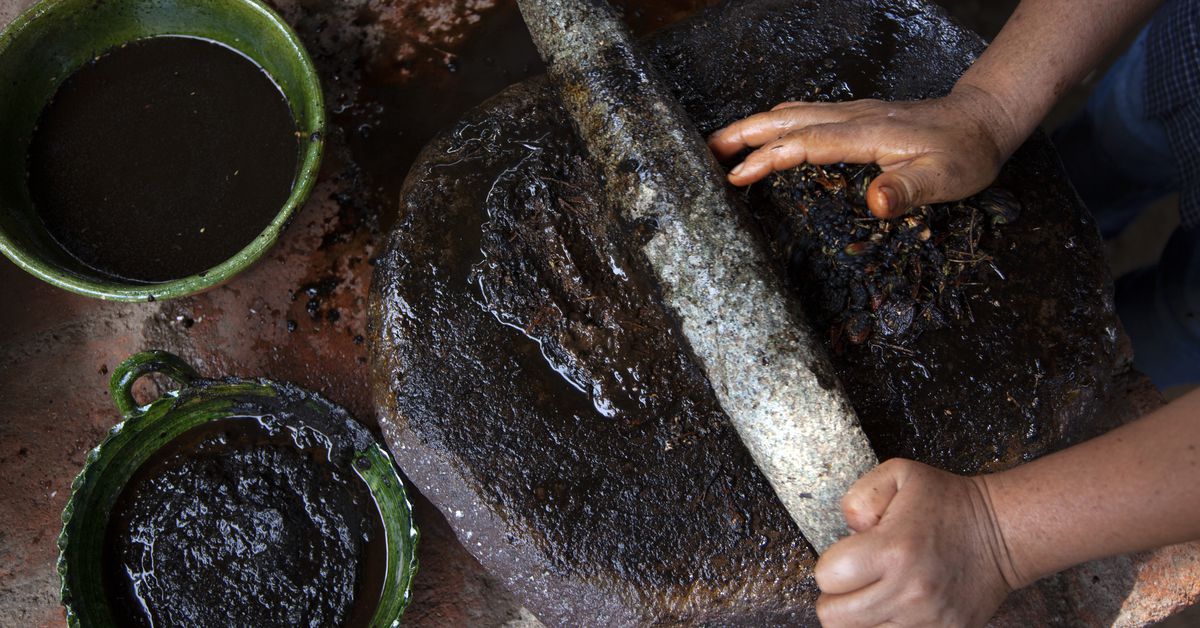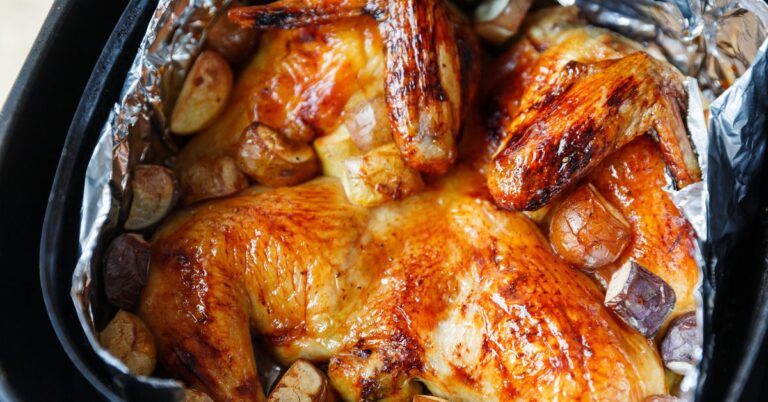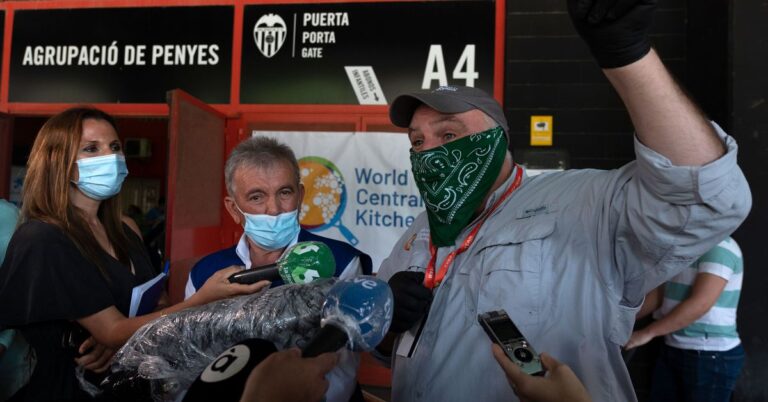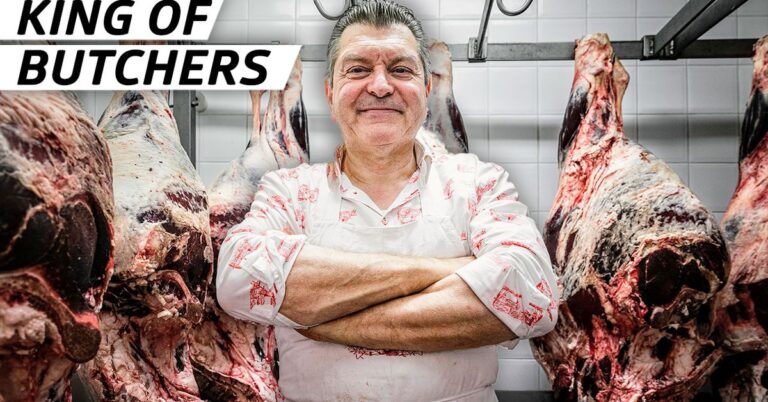How Mole Is Made by Traditional Methods in Oaxaca
“In the village, people used to say that breathing the smoke from the chiles was good for you,” says Elvia León Hernández, coughing a bit from the plume as she tosses a combination of dried, thick-skinned chilhuacle chiles and ancho chiles on her comal. She moves the chiles continuously with an escobeta, a brush made from dried palm leaves, as the fire burns beneath the clay griddle in the garden of Alfonsina, the restaurant she runs with her son Jorge León on the outskirts of Oaxaca. León Hernández is making mole negro, the most emblematic of Oaxaca’s moles. It’s the one everyone talks about, the one with the seemingly endless combinations of native and foreign ingredients, and she’s been making it for more than 30 years.
When the chiles are stiff, resembling pieces of charcoal, she sweeps them off the comal into a bowl with a piece of cardboard. She toasts other ingredients, the driest first: ancho chiles, almonds, sesame seeds that have been soaked in water, cinnamon sticks, raisins, garlic, oregano, thyme, clove, cumin. A ripe banana, peel and all, goes into the charcoal beneath the comal beside onions, then tomatoes and tomatillos. The seeds of the two chiles are toasted. After the banana and vegetables are removed, the chiles are crunched in her hands into even smaller pieces. Then she turns her attention to the metate.
:no_upscale()/cdn.vox-cdn.com/uploads/chorus_asset/file/23217170/elvia_jorge_alfonsina_portrait.jpeg)
Juan de Dios Garza Vela/Eater
Alfonsina’s metate, a tool made of river stone used to grind chiles and other ingredients, is curved and clunky, and estimates it’s probably been in use for at least 40 years. She places a handful of chiles on the old stone, sprinkles them with water, then works small amounts of the chiles with the mano, or roller, which she grips firmly with both hands. It’s less of a rolling motion than a pushing downward and dragging back while flicking her wrists. She knows the mixture is ready when it is smooth — when the chiles have melted into the metate.
She repeats the process with the vegetables, and then with the herbs and nuts. It takes hours and muscle. As she grinds the mixtures again and again, she reminisces about making mole in Santo Domingo Nundo, her home village, almost 200 kilometers to the northwest. There would be about a dozen women lined up with their metates, side by side, grinding on the stones. She can still hear the wind in the trees, she says, as they made mole and passed the time together. “We talked about life, the fields, the corn and beans,” she says. “It was soothing.”
When each mixture for her mole negro has reached its desired consistency, she heats manteca (pork fat) in a clay pot that has been set on some bricks over a wood fire a few steps from the comal. She adds the chile mixture, then the seed mixture, some chocolate, and the rest. She sprinkles in a little bit of salt, then water and chicken broth, bit by bit. She stirs continuously for the next couple of hours, and the pot bubbles and splats and smokes.
When you taste León Hernández’s mole negro, which may appear with a protein or on an antojito (a masa-based snack like tlayudas and tamales), depending on how she is feeling that day, not one of the 18 ingredients stands out. That’s how she says it’s supposed to be. Through the smoke of the comal, the grinding of the metate, and the heat of the fire, everything becomes one.
The word “mole” is derived from the Nahuatl word “mōlli,” which roughly translates to “watery food,” such as a sauce or stew. Mexico’s 18 ethnic groups have been making moles long before the introduction of foreign ingredients like onions and sesame seeds. Mole’s defining technique, the grinding of chiles and other ingredients on a metate, has Indigenous roots, and these early moles used what was native: chiles, tomatoes, wild greens called quelites — a wide variety of ingredients depending on the local microclimate, of which Oaxaca has many. Some of the moles made in rural villages today still resemble these, and many dishes one might recognize as mole aren’t necessarily called mole; they might be known by Indigenous names or a reference attributed to a particular village.
Oaxaca’s so-called seven moles — negro, rojo, coloradito, amarillo, verde, chichilo, and manchamantel — have over time included some ingredients more associated with the postcolonial era: onions, garlic, sesame seeds, and certain spices. Many moles in the Valles Centrales contain a thickener: Nuts, raw or cooked masa, and tortillas were frequently the Indigenous approach, but now traditional cooks may use bread or ground sesame seeds, if a thickener is even used at all. Tortillas, as the accompaniment, are the only essential complement. “There isn’t a standardization,” Jorge explains from a table at Alfonsina in between services. “No one can define if [something] is mole or it is not. Everyone has their own definition.”
:no_upscale()/cdn.vox-cdn.com/uploads/chorus_asset/file/23217159/elvia_comal_mole.jpg)
:no_upscale()/cdn.vox-cdn.com/uploads/chorus_asset/file/23217154/IMG_9549.jpg)
:no_upscale()/cdn.vox-cdn.com/uploads/chorus_asset/file/23217202/IMG_9602.jpg)
For cook Veronica Aquino Ambrocio, who works in the kitchen of a reforestation project in San Martín Tilcajete, mole means the warmth of caldo de guajolote, the soulful turkey broth that gives the moles of Santa Ana Zegache in the Central Valley their signature flavor. She mixes the broth with chiles when making her mole negro or coloradito. When she was growing up, there was no meat to accompany the mole — her family couldn’t afford it — so they used white beans instead. For Carina Santiago, who owns two restaurants in Teotitlán del Valle, mole evokes the sound of her grandmother grinding fresh oregano and thyme on a metate to make mole de castilla, which is often thickened with bread and served with turkey. For Thalia Barrios García, owner of Levadura de Olla in Oaxaca and whose hometown of San Mateo Yucutindoo in the Sierra Sur sits in the mountains, mole means the surprise of family members delivering baskets of wild mushrooms to her family’s house; those relatives would wake at 4 a.m. to collect the mushrooms to make mole amarillo con hongos.
In other words, in restaurants, houses, and markets around Oaxaca, everyone makes their mole a little differently. Some might use ancho chiles when others use costeños. Some might use bread to thicken the sauce, while others might use masa. Some might char the chiles longer than others. Some might use a blender when others use a metate. Oaxaca isn’t the land of seven moles; it’s the land of 7,000 moles. The more you try to define them, the more you realize they cannot be defined. They are everything. They are nothing.
I first met León Hernández and León in late 2018, not long after they opened Alfonsina together. In the years before, she had been making tortillas daily and selling them, along with various antojitos, to neighbors, while León had been working in professional kitchens, first at Casa Oaxaca, where he learned to prepare traditional Oaxacan dishes. Later, he’d become an integral part of Pujol in Mexico City — Enrique Olvera’s internationally renowned restaurant known for its Mole Madre, Mole Nuevo dish — and of other parts of Olvera’s restaurant group, in charge of the moles and masa.
When León returned to Oaxaca, he wanted to create something with his mother at their family home in San Juan Batista la Raya. Every peso he saved went into buying kitchen equipment and building a small dining room with a comal. They cleaned up the courtyard, adding tables and an outdoor kitchen with another comal and a fire pit. At first it was just mother and son, but the team quickly grew, as is evident in the kitchen before a recent lunch service. León’s stepfather Macedonio García is nixtamalizing the corn in a large pot over an open fire in the courtyard to make tomorrow’s masa. León’s brother Rubén, the sous chef, is peeling pitaya and crushing almonds for the dessert course, while his wife Claudia is handling reservations and managing the dining area. There are aunts and cousins prepping, making tortillas, and waiting tables. They are all wearing T-shirts that say “Familia.”
Landrace corn, a Mexican heirloom variety, is the backbone of the Alfonsina menu: In the morning it is among the traditional foods of León Hernández’s comida corrida, and in the afternoons it appears on León’s menu, which is more free-form and served for lunch and dinner. The corn, which the duo sources from small farmers in their ancestral village, is used in tortillas, tlayudas, sopes, tamales, and tostadas. But the moles are a constant.
Mole is a living, breathing document shaped by personal experiences and specific inspirations. León Hernández’s moles are inspired by a mix of the mole she grew up making and the classic mestizo preparations of the valley. In her village, they made only one kind — a red spicy mole somewhat similar to a coloradito. Chiles were eaten with everything there, and there were none of the foreign seeds or spices from abroad that she now uses in her mole negro. When León Hernández moved to Oaxaca, her mother-in-law taught her about mole negro and estofado. Finding them too sweet, León Hernández adapted them with less sugar and more chiles, in the style of her village, creating her own recipes.
:no_upscale()/cdn.vox-cdn.com/uploads/chorus_asset/file/23217174/BB7BE74C_5FEB_4C89_9799_742B80E40440.jpeg)
Juan de Dios Garza Vela/Eater
León can remember his first taste of his mother’s mole in Santo Domingo Nundo. Elvia handed him a cucharilla, a variety of Dasylirion that they now use as spoons at Alfonsina, and the mole was vibrant and alive. Even then he sensed that it wasn’t just food but something more: He’d have it at birthday celebrations, a wedding, or for Semana Santa (Holy Week) alongside shrimp cakes called tortitas de camarón. “The occasion was secondary,” he says. “Just preparing the mole was a celebration in itself.” To some purists, León’s moles might not even be considered moles. They are fresh moles, more pre-Hispanic and like the moles of rural villages that are inspired by native produce: whites, greens, and yellows usually, expressions of the season, sometimes made with things like yuca or pulque. He comes up with many of them while gathering produce at Oaxaca’s Mercado de Abastos. Like his mother’s moles, they lean spicy.
“I think they are developing and growing,” León Hernández says of her son’s moles. “They’re surprising. I love them.”
Each has a tremendous respect for the other’s work. They’re often in the kitchen together: He might show her a way to clean the chiles to extract the maximum amount of flavor or explain why it’s important to use one ingredient over another. She might teach him a particular way to grind an herb. Sometimes in the kitchen, she’s stirring one of his moles, and he is grinding chiles for hers — so it is hard to tell where one mole ends and the other begins.
As he makes his moles at Alfonsina, León can track how his approach to mole extends backward through time. When he was 18 and in the kitchen at Casa Oaxaca, someone told him to make the restaurant’s moles, handing him recipes for large batches — the restaurant would make them 50 kilos at a time. In those days, he says, he had zero experience making mole: Girls are taught to make mole when they are young, but not boys. “I had to just figure it out,” he says. It was the moment he started to become more interested in his mother’s cooking, setting him off on a never-ending journey of trying to understand who he was and where he was from.
As León Hernández watches her son make his mole, she remembers when she was 20, arriving at San Juan Batista la Raya, right beside the airport, from her village en route to the United States. “It was supposed to be just a stopover,” León tells me. “Everyone in the village was migrating there.” Santo Domingo Nundo was emptying out. León was 4 years old at the time, and moving to the States would mean he wouldn’t remember Mexico or the pueblo. León Hernández understood what that meant — not just for her son but for everyone. She told her family that she had changed her mind. “We aren’t going to leave,” she said. “We’re staying in Oaxaca.”
In the early morning, while most of Oaxaca is still sleeping, I’m walking with León through the Mercado de Abastos. In the past, he explains, every vegetable and chile was some sort of heirloom variety grown within an area’s specific microclimate. But at some point in the last few decades, as access to commercial products became easier, things started to change. People in the village stopped using things like panela and handcrafted salt in favor of much cheaper industrial sugars and salt. These weren’t just changing the mole’s flavor; they were changing an entire ecosystem of ingredients and the livelihoods of everyone involved with them. When we find a group of vendors from rural communities far from the city, their piles of avocados and tomatoes are spread out on blankets and folding tables. “I had to convince my mother to start using tomato riñon,” León says as he holds up a large red tomato with grooves along the sides. “She was used to picking out whatever was cheapest. She didn’t understand why she should be paying five times more for a tomato.”
:no_upscale()/cdn.vox-cdn.com/uploads/chorus_asset/file/23217176/IMG_9842.jpg)
It was important to León that Alfonsina make the same shift. The corn, in particular, would be sourced from small farmers in Santo Domingo Nundo. He’s constantly going out in search of ingredients around the state of Oaxaca that are being forgotten or displaced. In the sierra, he’s found a community growing criollo chiles and making chintextle, a smoked chile paste. On the coast, he is sourcing criollo hibiscus flowers and working with sustainable-fishing communities in Puerto Escondido. In the jungle in La Chinantla, he found someone growing cacao, while in La Mixteca he is buying pulque and wild mushrooms. Alfonsina is becoming an ecosystem of its own for these types of producers, as well as for his own family.
Back at the restaurant, León is preparing a mole he dreamed up that morning in the market. He’s never made it, but he’s confident about the flavors. There are pumpkin seeds, which he grinds in a Vitamix. He chops parsley, garlic, and onions and adds them to a hot pan with whole manzano chiles, a sort of fatter, larger habanero that isn’t quite as hot but maintains the same flavor. After a few minutes, he adds squash blossoms. Lots of them. After sautéing them for about 30 minutes, they wither and melt in the pan.
In the blender, he adds some of the mixture. He tastes it and nods his head. He blends some more, tastes it, then adds some more from the pan and blends it until the Vitamix starts steaming. He sautes some parsley, adds it to the blender for a minute, then dumps everything back into the pan. Stir, back to the blender, back to the pan, more chile: Everything goes back and forth until the mixture has just the right texture and flavor. He passes a cucharilla with some of the mole on it to León Hernández, and she nods her head. Just like his mother’s moles, no single flavor stands out, but it’s a touch spicy.
:no_upscale()/cdn.vox-cdn.com/uploads/chorus_asset/file/23217216/IMG_9812.jpg)
As he cooks some fish and mustard leaves that are going to be served with this unnamed mole, we start talking about Pujol’s famous Mole Madre, Mole Nuevo dish. Maybe the most symbolic fine-dining recipe in modern Mexican cuisine, it’s a two-mole plate where an older mole negro that keeps getting fed with new black mole every few days, similar to a masa madre (or sourdough starter), is topped with a fresh mole rojo.
For visitors and the international food set, the Pujol dish is avant-garde, something that dramatically pops on Instagram, but it borrows from long-standing traditions during village celebrations. In Oaxaca, it often takes five days to make a mole, sometimes more. The first few days involve preparing all of the chiles: cleaning, charring, grinding. Then there’s the day of the celebration, when the mole is eaten by everyone in the community. But it’s the day after that initial serving when people reheat the mole in their houses — the famous recalentado, meaning “reheated” — which results in a much deeper flavor.
“My mother taught me how special this was,” León says. “Reheating isn’t for the entire village but just your family. It’s more important. That’s the concept for Mole Madre, Mole Nuevo: recalentando, recalentando, recalentando.” This reheated mole is traditional, a comforting meal not made for tourists but for the people of Oaxaca. As long as there are moles being made, it will always be there the next day.
It was Olvera’s idea to add the mole nuevo atop the mole madre, León says, so diners could try the two moles together and taste the differences created by the passage of time. At that moment, in the kitchen at Alfonsina, León has the idea to plate his mother’s mole negro on the same plate with the light-green mole he just made. It isn’t one on top of the other, though; they are plated side by side.
Writer and photographer Nicholas Gill is the co-author of the Latin American Cookbook and writes the Substack newsletter New Worlder. Juan de Dios Garza Vela is a photographer specializing in food and travel. When he isn’t doing photo work he also does illustration work and murals. Based at the moment in Guadalajara, he can’t imagine life without tacos.







